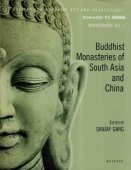Lao: 2 definitions
Introduction:
Lao means something in the history of ancient India, biology. If you want to know the exact meaning, history, etymology or English translation of this term then check out the descriptions on this page. Add your comment or reference to a book if you want to contribute to this summary article.
India history and geography
Source: Shodhganga: Vernacular architecture of Assam with special reference to Brahmaputra ValleyLao is a Tai Ahom term referring to “rice beer”.—It appears in the study dealing with the vernacular architecture (local building construction) of Assam whose rich tradition is backed by the numerous communities and traditional cultures.

The history of India traces the identification of countries, villages, towns and other regions of India, as well as mythology, zoology, royal dynasties, rulers, tribes, local festivities and traditions and regional languages. Ancient India enjoyed religious freedom and encourages the path of Dharma, a concept common to Buddhism, Hinduism, and Jainism.
Biology (plants and animals)
Source: Google Books: CRC World Dictionary (Regional names)Lao in Thailand is the name of a plant defined with Saccharum spontaneum in various botanical sources. This page contains potential references in Ayurveda, modern medicine, and other folk traditions or local practices It has the synonym Tricholaena semidecumbens (Roxb.) Schult. (among others).
Example references for further research on medicinal uses or toxicity (see latin names for full list):
· Plantae Indiae Batavae Orientalis (1856)
· Journal of Cytology and Genetics (1983)
· Monographiae Phanerogamarum (1889)
· Voyage autour du Monde (1829)
· Flora Indica; or descriptions … (1820)
· Wissenschaftliche Ergebnisse der Schwedischen Rhodesia-Kongo-Expedition, 1911–1912, unter Leitung von Eric Graf von Rosen (1911)
If you are looking for specific details regarding Lao, for example chemical composition, pregnancy safety, side effects, extract dosage, diet and recipes, health benefits, have a look at these references.

This sections includes definitions from the five kingdoms of living things: Animals, Plants, Fungi, Protists and Monera. It will include both the official binomial nomenclature (scientific names usually in Latin) as well as regional spellings and variants.
See also (Relevant definitions)
Starts with (+56): Lao bai hua, Lao di sheng gen, Lao fen, Lao keshra, Lao laeng, Lao ling, Lao niu jin, Lao qiang gu, Lao shu le, Lao shu shi, Lao shu shih, Lao tou, Lao wo sheng, Lao ya hu, Lao ya yan tong hua, Laoa, Laogo, Laokeshar, Laokwo, Laolaeng.
Ends with (+3): Alomboromahalao, Ayneepillao, Bhilao, Bu tulao, Bulao, Bunlao, Butalao, Caay phi lao, Deolao, Elelo, Galao, Halimboro mahalao, Kandlao, Kanlao, Kiao klao, La-buu-lao, Lo, Nam-lao, Navalo, Oi lao.
Full-text (+63): Laos merah, Theravada, Lao tou, Laos, Lao keshra, Lao ling, Lao fen, Lao wo sheng, Lao niu jin, Lao bai hua, Caay phi lao, Ormusalala lao laguria, Oi lao, Ci lao ya, Ai lao guan cao, Ye lao guan cao, Lao shu shih, Ruan mao lao guan cao, Lao qiang gu, Yuan ye lao guan cao.
Relevant text
Search found 32 books and stories containing Lao; (plurals include: Laos). You can also click to the full overview containing English textual excerpts. Below are direct links for the most relevant articles:
International Affairs: A Survey < [July 1962]
The Continuing Crisis in Vietnam < [July 1965]
International Affairs: A Survey < [July 1970]
Shakti and Shakta (by John Woodroffe)
Chapter XI - Śakti in Taoism < [Section 1 - Introductory]
Philosophy of language in the Five Nikayas (by K.T.S. Sarao)
2. The Buddhist Pāli Tipiṭaka (Introduction) < [Chapter 1 - Introduction]
Maha Prajnaparamita Sastra (by Gelongma Karma Migme Chödrön)
Part 6 - Viśvantara-Jātaka (or Vessantara-jātaka) < [Chapter XX - The Virtue of Generosity and Generosity of the Dharma]
Part 8 - Jātaka of the king who set fire to his body so as to hear a Buddhist stanza < [Chapter XIX - The Characteristics of Generosity]
Act 4: The Buddha stretches out his tongue and smiles a third time < [Chapter XIV - Emission of rays]
Chaitanya Bhagavata (by Bhumipati Dāsa)
Verse 2.18.47 < [Chapter 18 - Mahāprabhu’s Dancing as a Gopī]
Verse 3.4.311 < [Chapter 4 - Descriptions of Śrī Acyutānanda’s Pastimes and the Worship of Śrī Mādhavendra]
Verse 2.23.331 < [Chapter 23 - Wandering about Navadvīpa On the Day the Lord Delivered the Kazi]
Socially Engaged Buddhism (with reference to Australian society) (by Phuong Thi Thu Ngo)
The Origins of Buddhism < [Chapter 3]
Buddhist and Its Developed Period in Australia < [Chapter 3]
The Festival of Theravada Tradition < [Chapter 4]
Related products
